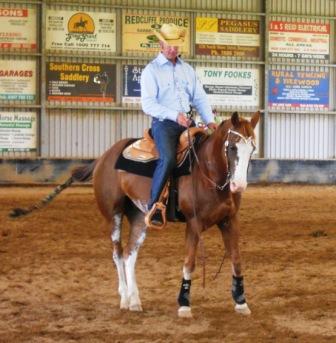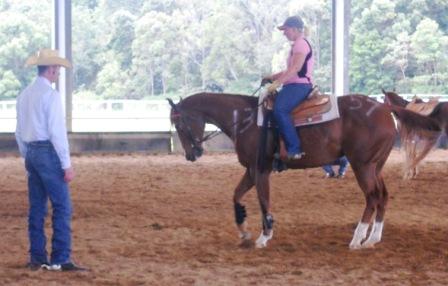Horsezone News
SEQAC Mark Shaffer Clinic
Published on Tuesday, November 9, 2010 in Training and Clinics

Queensland put on its best weather for the 3rd annual SEQAC Mark Shaffer Clinic, which was held from 6 - 8 November, at Burpengary Equestrian Centre. There were 13 riders and approximately 15 fence sitters in attendance, which meant everyone received plenty of attention from 'The Master' of western performance horse training, Mark Shaffer. Once again, SEQAC (www.seqac.org) organised a great clinic, which had not only Mark's great teaching, but plenty of good food and fun company! Many of the riders had attended previous Mark clinics, saying they like to attend once a year, usually on a different horse, as a refresher course. The riders included established and respected trainers as well as amateurs, all of whom swear by Mark's system. Fence sitters were not forgotten and were involved in Mark's question and answer sessions, as well as his daunting (but very necessary!) 'tests'. There is no choice but to learn when you're going to be asked to answer a question, in front of 30 of your peers!
Mark Shaffer is based in the USA and only visits Australia once a year. He has won well over 100 World Championships and has coached many Amateur and Youth riders to similar success. Mark is undoubtedly one of the World's best western trainers and he is more than happy to pass on his secrets to success during the Mechanics N Motion Clinics.
Attendees at a Mark Shaffer Clinic usually leave feeling like their minds (and legs) are mush, after such intensive lessons, however, with his great communication skills (and the 'tests'!), Mark ensures that you go away knowing a lot more about the mechanics of your horse and how to train him effectively, than when you arrived!

Mark teaches a specific system of training exercises, which can be performed with varying degrees of difficulty, depending on the training and fitness level of each horse. The aim of these exercises is to not only make your horse physically strong but also to provide mental focus. Mark realises that many of us have World Champions at home, however, once we get out to a show the wheels sometimes fall off, often this is more due to lack of mental focus than training or ability. Mark's training system ensures that you can achieve mental focus from your horse, regardless of the surroundings. Loping around and around in circles will never achieve a physically strong and mentally focused horse.
Mark continually reiterates throughout the clinic that you need to understand why you should do particular exercises and identify specific problems, so that you can work on the best exercise to help with that issue. Mark uses arc and reverse arc body positions for most of his exercises include side passing, which is a 3 beat system the same as the lope, teaches balance and enhances drive, body control and suppleness. He then works on 8 different pivots (2 pivots for each leg - forehand and hindquarter - arc and reverse arc) these different pivots provide various benefits for your horse and Mark extensively covers the attributes of each pivot so attendees know what they most need to work on with their horse. To make it even easier to understand the varying degree of difficulty and uses for the different pivots, Mark drew big numbers (1 to 8) on the appropriate spot of several horses - shoulders or rump - and then had the riders demonstrate for the other attendees - 1 and 2 are the simplest pivots (reverse arc forehand) and 7 and 8 are the most difficult (arc hind quarter). These are just the start of the exercises - there are many variations and also more advanced combinations of the manoeuvres, which incorporate trot, lope and counter canter. Backing up is also an important exercise in Mark's program as it strengthens the horse's back, legs and flanks and gives body control.
But wait there's more! To further educate riders, Mark uses the letters FRSPT to outline what we are looking for from our horses. F = forward, the engagement of power (but not running on or away!); R = release, a relaxed jaw, rib cage and hind quarter (as in you're not fighting each other); S = suppleness, the beginning of collection (rounded back, soft mouth); P = position, the horse's body position needs to be correct for him to do his job (eg: he has to be shaped correctly to pick up a lead properly); and T = transitions, a precise transition is essential as it gives improved cadence once you are in the gait (a western pleasure class is really a group of transitions, the better the transitions the more likely your horse will move well in each gait and score highly)
I realise the above may sound exhausting but for anyone interested in horse training, it's actually fascinating and there was plenty more covered that we haven't gone into here. Basically, anyone who is interested in owning and riding a well trained, physically fit and mentally focused horse, needs to attend one of these brilliant clinics! All attendees had a very rewarding weekend and have now gone away with the tools to train their horses effectively with Mark's proven system. No doubt everyone will be lining up for the 2011 clinic - I know I will!
[URL="http://www.horsezone.com.au/gallery/SEQAC-Mark-Shaffer-Clinic-55"]CLICK HERE[/URL] to visit the Horsezone Mark Shaffer Clinic Gallery and [URL="http://www.markshaffershowhorses.com/index.php"]CLICK HERE[/URL] to visit Mark's great website.
Be the first to comment on this article
You must be logged in to place comments
News Search
Categories
- General
- Event Results
- Stallionzone
- Sponsored Shows
- Clubs
- Health
- Feature Horses
- Competitions
- Five Minutes With Horsezone
- Young Riders
- Reviews
- Training and Clinics
- Postcards from the saddle
- 2014 Equitana by HORSE FIRST
- 2013 Equitana
- 2012 Equitana
- 2012 London
- 2011 Equitana
- 2011 Queensland Floods
- 2010 WEG
